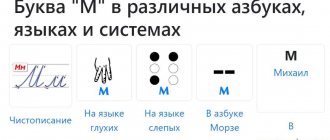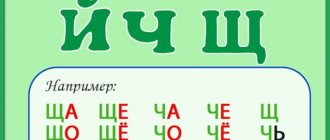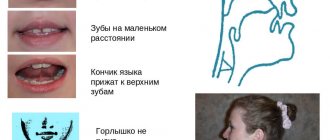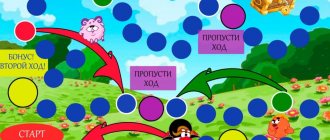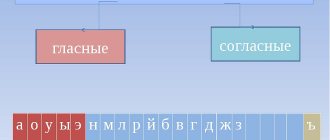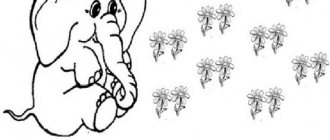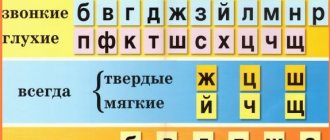letter m soft or hard
Previously, children learned to read at school, and few parents were concerned about homeschooling. Nowadays, although children go to school earlier, not from 7, but from 6 years old, they are already required to know the alphabet, and in some schools even the ability to read.
You can hire a tutor for your child or send him to developmental classes at a special children's center, or you can teach your child to read at home. After all, home activities not only develop the child, but also provide the opportunity for additional communication with mom and dad.
My child learned to read at the age of 3, although not without the help of one very good teacher, who gave our studies an impetus, and then we developed ourselves. Therefore, I now know what pitfalls there can be in teaching a preschooler to read.
First, buy the right primer.
The correct primer is built on the method of teaching reading syllables at a time, that is, the child learns to read syllables, not letters. I can recommend 2 primers that we had: A.N. Tkachenko and N.S. Zhukova.
Secondly, when teaching your child the alphabet, teach sounds, not letters.
That is, all consonants should sound like “b, p, m,..”, and not “be, pe, em..”, etc. As for vowels, show your baby that, unlike consonants, they stretch and that they can be sung. By the way, singing vowels is also a very good speech therapy exercise.
Thirdly, nothing should be done by force, the child should perceive learning as a game,
therefore, it would be useful to purchase toy aids: a magnetic alphabet, cubes with letters, a wall alphabet (carefully choose a speaking alphabet, it must have a function for teaching sounds, not letters), lotto, coloring books with letters. Kids remember better what a letter looks like if you make it out of matches, mold it out of plasticine, and try to learn how to write. The game “What letter does the word begin with?” gives amazing results for learning to read. As soon as the baby begins to identify the letter by ear, understanding the composition of syllables will become easier.
Now about the training itself - we teach the child to read syllables correctly.
Start teaching your child to read from syllables with the letter A. Once you have learned the letter A, then take turns learning the consonants and making syllables starting with A from them: “ba, pa, ma, la, va,” etc. At the same time, you learn syllables with reverse reading of the letters “ab, ap, am, al, aw.” The child must understand that the position of the letters relative to each other affects their reading.
To explain to your child how to form a syllable, try to stretch the first consonant to a vowel, it’s convenient to start with hissing and wheezing letters, and when the baby understands the essence, then learn other letters. For example, you read: “SSSSSS-A, it turns out SA”, “ХХХХХ-A, we got HA”.
When your baby already remembers reading a few syllables, start making simple words from them.
, for example, “ma-ma, ba-ba, la-va, la-ma”, etc. Complicate the lessons with words of three syllables, for example, “pa-na-ma, ka-na-va.”
The next stage is learning to read words
, which consist of syllables and individual letters, of syllables with different combinations of vowels and consonants, for example, “ma-k, ra-k, ka-r-ta, pa-r-ta, ar-ka.” To make it more interesting for your child, model learning a new letter with a game. Be sure to make up as many words as possible starting with this letter, draw it, mold it, prepare food from words starting with this letter, for example, C - soup, plum, K - porridge, cabbage, P - rice, horns, A - orange, azu and etc. Remember the fairy-tale characters starting with this letter and before going to bed, be sure to read a fairy tale about it, for example, P - little pigs ("The Three Little Pigs"), S - Snow Maiden, R - Turnip, etc.
When the baby masters syllables with the letter A, even without having learned all the consonants, you can move on to the next vowels, for example, the letter O.
Then the order is the same, simple words, more complex ones. Now you can make the first sentences from words, for example, “Ma-sha ma-la, Vo-va small.” Having gone through all the vowels, your baby will be able to read the cherished “Ma-ma we-la ra-mu”!
Finally, leave a soft and hard sign, as well as the letter Y
. It is very good to read several words that end in the same way with these letters, for example, “ma-yka, ra-yka, pa-yka”, “so-l, mo-l, ro-l”, etc.
Reinforce the material you have covered by making words from a magnetic alphabet or cubes.
For example, we read before meals, this game intrigues my daughter and even increases her appetite, because she eats what is written from the letters in the refrigerator. For example, “Read what I prepared for you?” "Soup". “Now read, what’s in the soup?” “Onion, meat, ma-ka-ro-ny, kar-tosh.”
It is very useful to play school, it is both preparation for the school environment and order, and a wonderful role-playing game
. Moreover, usually children do not want to take on the roles of themselves, they are interested in trying on the role of adults, because in our home school I am always a student, and my daughter is a teacher. She gives me the task to write this or that word, and I write either correctly or incorrectly. The “teacher” corrects me and gives me a grade. For example, “Children, write the word BARREL!” And I write “bechka”, the child reads and corrects E to O. The further it goes, the more difficult it is. Learn to spell words with the letter O “milk, cow”, etc., as well as the rule “Zhi, shi write with I.” Believe me, a four- to five-year-old child can do this. And already at the age of 5 you can start reading the first books, for example, from the “Reading by Syllables” series.
If something doesn’t work out for your child, or he doesn’t want to study, don’t be nervous or upset, put off the lessons for a while.
In the end, it happens that the mother does not have teaching talent, then you can send the child to a children's center, where they know exactly how to teach a child to read correctly, and reinforce the skills at home with games and tasks. Believe in your baby, you will succeed!
Author: Tunic Ariadne
Sound automation [L]
- Speech therapist.No
- Automation of sounds
- Sound automation [L]
The hard consonant sound [L] is colored blue (hard consonant). Vowel sounds are colored red.
The sound [L_] is pronounced for a long time and only with a motionless tongue (see articulation of the sound [L]).
1) Pronounce (read) syllables with the sound [L_]
Sample: al__, ol__, st__, yl__, el__, il__, el__, yol__, yul__, yal__
2) Pronounce (read) words with the sound [L] at the end
Sample: floor__, y-goal__
|
|
|
|
|
3) Pronounce (read) words with the sound [l] in the middle
Sample: floor, and head
|
|
|
|
4) Pronounce (read) the syllables L__A, A__O, L__U, L__Y, L__E
5) Pronounce (read) words with the sound [L] at the beginning
Sample: l__ak, l__a-pa
|
|
|
|
|
6) Pronounce (read) words with the sound [l] in the middle
Sample: ka-l__ach, sa-l__at
|
|
|
|
7) Pronounce (read) syllables
Sample: k-l__a, k-l__o, k-l__u, k-l__y
|
|
 Pronounce (read) words with a combination of consonants with the sound [L]
Pronounce (read) words with a combination of consonants with the sound [L]
Sample: f-l__ag, p-l__a-val__
|
|
|
|
9) Pronounce (read) words with two sounds [l]
Sample: f-l__ag, p-l__a-val__
|
|
|
|
10) Pronounce (read) phrases
Sample: SAMPLE: White ha-l__at
- Blue dress.
- Bright moon.
- Bad boat.
- Yellow scarf.
- Broken saw.
- Cold basement.
- Hungry wolf.
- Thick stick.
- Heavy hammer.
- Ripe strawberries.
- A warm coat.
- A spiky tree.
- Tin soldier.
- Golden ear.
- Blue eyes.
- Silk blouse.
- Deep well.
11) Conjugate sentences
- I ate milk noodles.
- I bought a notepad and chalk.
- I broke my bike.
- I was sailing on a boat on the waves.
- I ate ripe strawberries.
Sample:
- I drank cold milk.
- You drank cold milk.
- He (she) drank cold milk.
- We drank cold milk.
- You drank cold milk.
- They drank cold milk.
12) Say (read) sentences
Sample: Mi-l__a pi-l__a mo-l__o-ko
- There was a table next to the table.
- Volodya went to the collective farm.
- Alla bought a white dress.
- Mila carried the blue flag.
- A boat floats on the waves.
- Klava clapped her hands.
- Klusha swept the floor.
- The elephant has white tusks.
- The squirrel was sitting near the hollow.
- Klava bought onions and beets.
- Mila ate strawberries from a basket.
- Nikolai broke his bike.
- Volodya forgot where he put his pencil case.
13) Pronounce (read) pure sayings
- He sat down and ate everything.
- Near the bell stake.
- Klava deftly chopped the onion.
- Mom didn’t spare soap; mom washed Mila with soap.
- The stake is near the table, the table is near the stake.
- Polkan pushed the stick with his paw.
- Alyonka sat down in the corner - Alyonka had a lot to do.
- The nightingale is not great, but its voice is golden.
- Put off idleness, but don’t put off doing things.
- A cap under a cap, a cap under a cap.
- Here the cheerful bun rolled like a ball.
- Fyokla’s beets were wet and dry.
- Slava swam on a raft and caught roaches from the raft.
14) Pronounce (read) and retell the text
Naughty
Mila had a cat. He was completely white. Mila named him Belyak. Belyak was a big naughty man. One day Mom was knitting new socks for Mila. There was a ball on the table. Mom left the room and left the ball on the table. The white hare jumps onto the chair, from the chair onto the table, and let’s push the ball with his paws. The hare pushed and pushed the ball and tangled all the threads. Mila entered the room, saw a ball on the floor and said: “Oh, what a naughty man you are, Belyak!”
15) Say (read) poems
White snow, white chalk, The white hare is also white. But the squirrel is not white, the squirrel was not white.
Grandfather planted onions and grew an onion. The grandson saw the bow and tore off the forelock of the bow.
Klava deftly chopped onions, Lala washed the floor and shelves, Volodya knocked out the dust, Valya hammered nails, Kolya merrily sawed, Anatoly washed the forks, and little Sveta ate sweet candies.
- White hare, white hare! Where did you run after the bast? The white hare answered: “I didn’t run, I galloped.”
16) Pronounce (read) and memorize a poem
Clown weirdo
The weirdo clown did everything wrong: He dug with a crowbar, broke with a shovel. He sewed with a chisel and chiseled with a needle. He sawed with a cleaver, stabbed with a saw. I used a broom to whitewash and chalk with a brush.
Summary of speech therapy lesson topic: Sounds M - M. Winter.
Goal: To consolidate children’s understanding of the sounds M - M, to introduce them to the letter M;
Tasks:
Educational:
- automate the sounds in speech; - to consolidate children’s ideas about the articulatory structure of the sounds M - M; — practice the skill of isolating a given sound in a word, determining the place of a sound in a word; - to develop the ability to isolate and distinguish the sounds M - M and letters in syllables, words and sentences, relying on auditory, visual, kinesthetic and tactile self-control; — Consolidating ideas about winter and its signs; — Clarification, expansion and activation of the dictionary on the topic “Winter”; — improving the grammatical structure of speech (coordination of adjectives with nouns);
Educational:
— develop phonemic perception, sound analysis and synthesis skills; - develop long, smooth exhalation, visual attention, thinking, articulatory, fine and gross motor skills, coordination of movement.
Educational:
— to cultivate in children a positive attitude towards speech therapy classes and a culture of behavior during them.
Equipment: Mirrors for each child, articulation profiles, letters, multi-colored chips (symbols of sounds), counting sticks, sound rulers, a toy Christmas tree, toys, a Santa Claus figurine, an image of a traffic light, subject and subject pictures, a sandbox with sand.
During the classes
1. Organizational point:
White snow lies all around Snowflakes are falling Oh! Frost is behind the tree. Sit down, children, hide your nose. Guys! Do you like to solve riddles?
The cold weather has set in. The water has turned to ice. The bear stopped roaring: The bear fell into hibernation in the forest. Who can say, who knows, When this happens? That's right, guys, this happens in winter. Guys, do you love guests... Today fairy tale heroes came to our lesson. They hid in the sandbox. Go to the sandbox and dig them out. Who is this? That's right, Masha and the bears.
Psycho-gymnastics: - Remember and depict how scared Masha was; depict bears and imagine how happy Masha’s grandparents will be.
Breathing exercises: Guys, the new year is approaching soon. They say that the smell of tangerines is the smell of the New Year. (The speech therapist picks up a plate with tangerines and brings it to each child’s face). Let's smell the tangerine like this: we take a deep breath through our nose, not understanding our shoulders, and as we exhale we say the phrase “Oh, how delicious it smells!” The plate with tangerines is passed around the circle, and all the children do the exercise in turn.
2. Message about the topic of the lesson:
Today the heroes of the fairy tale “Masha and the Bears” came to our lesson. Psycho-gymnastics: - Remember and depict how scared Masha was; depict bears and imagine how happy Masha’s grandparents will be. What is the first sound we hear in the name Masha? And in the word Mishutka. Let's remember what sounds are? (This is what we hear and say). - Let's make the sounds [m], [m]. - How did we pronounce these sounds? Articulation of sounds (position of lips, teeth, tongue, passage of air, voice). - Let's denote the sound [m] with a sound circle. — We denote the sound [m] with a sound circle. - We put our finger on the blue circle - we “revitalized” this sound, now on the green circle - we “revitalized” it. Characteristics of sounds by acoustic characteristics. Guys, what can we tell you about these sounds? The sound [m] is a consonant, hard, sonorous, denoted in blue. The sound [m] is a consonant, soft, voiced, denoted in green. - How are these sounds different? - How are they similar? Guys, how is a sound different from a letter? That's right, we hear and pronounce the sound, but we write and see the letter. Guys, find the letter M in the sandbox. What does the letter M look like? (Children's answers).
I ask you to stand up and hold hands, friends. Holding hands, we stood up and began to look like Em. V. Stepanov. Draw the letter M in the sand.
Finger gymnastics
(Development of fine motor skills, coordination of speech with movement). I’m standing and holding snowflakes in my palm. Rhythmic strikes with the fingers of my left hand, catching them. Starting with the index finger, along the palm of the right hand. I love winter, and snow, and snowflakes. Rhythmic strikes with the fingers of my right hand. Starting from the index, along the palm of the left hand. But where are the snowflakes? clench your fists and unclench your fists in response. There is water in the palm of your hand, Where have the snowflakes gone? For the first question - squeeze, for the answer - unclench. Where? Fragile pieces of ice have melted - Small shaking with relaxed palms. rays... as you can see, my palms are hot.
3. Sound analysis and synthesis of syllables.
Next to the red circle (vowel sound) there is a blue one (vowel sound) - What is this? (this is a syllable) - How did you guess? (syllables are made up of sounds) - If this is the sound A, what will the syllable sound like? (AM), and if we change places - (MA), etc. - The vowel sound turns into I, the syllable sounds (IM), on the contrary it will be - (MI) - We change blue to green.
Vitya AK MORGENSHTERN killed more than once: Vitya MORGENSHTERN killed more than once mp3uk.net.
4. Working with the word.
Guys! Do you like to solve riddles? The cold weather has set in. The water has turned to ice. The bear stopped roaring: The bear fell into hibernation in the forest. Who can say, who knows when this happens? That's right, guys, it happens in winter. Today in our lesson we will talk about this wonderful time of year. Why? Right. There is a sound here [m], and how it sounds is firmly where it stands in the middle of the word. Well done! And now, we’ll rest - we get up and repeat the movements and words after me.
Physical education minute:
| Come on, buddy, be brave, buddy. | They walk in a circle, pretending to |
| roll | |
| Roll your snowball in the snow. | there is a snowball in front of you. |
| It will turn into a thick lump | They “draw” a large circle with their hands. |
| And the lump will become a snowman. | They “draw” a snowman from three lumps. |
| His smile is so bright! | They smile widely. |
| Two eyes, a hat, a nose, a broom. | Show eyes, close |
| head la- | |
| board touching the nose, | |
| stand up straight | |
| as if holding an imaginary broom. |
What did you and I make out of snow? That's right, a small and cute snowman (a picture of a snowman is posted).
You like? Small and cute can be replaced with the words small and sweet. Guys, tell me, in the word small and in the word dear, what are the first sounds - M - M. Let's lay out the audio track of the word small, and then the word mil (a sound analysis of these words is being carried out). Let's print the words and label the sounds.
Now, remember in which words that we pronounced in class you heard the sounds M - M. (winter, broom, Masha, com, Mishutka, be brave). Game “Dressing up the Christmas tree” (determining the position of sound in words). I will show you Christmas tree decorations, and you will determine the place of the sound M - M in its name and place the figure of Santa Claus on the red (beginning of the word), yellow (middle of the word), green (end of the word) traffic light rectangle, which will help us in our game. Toys: car, tangerine, feeder, bumblebee, gnome, house.
Let's change the game conditions. You will listen to the words and show at the traffic light the place of sounds in the words that I will name (blizzard, winter, lump, feeder, broke, frost, etc.)
4. Lexical - grammatical tasks.
(Working with antonyms, agreeing adjectives with nouns in gender and number.) Remind us who is visiting us today - Masha and Mishutka. Our heroes live in the southern part of our country and therefore they do not know what real winter is like. Let's tell them about this time of year.
Game: "Which one?" (with a ball). By the way, choose words that answer the question: what kind of winter is it? What's winter like? cold, frosty, snowy, elegant, harsh. Well done! (along the chain). And now, let's listen to Masha's story about winter, listen carefully, in case she got something wrong. Listen, she claims that:
- The weather is hot in winter and cold in summer. You agree, let's fix it one by one.
- Clothes are light in winter and warm in summer. Do you agree?
- In summer the sun is pale, and in winter it is bright. Do you agree?
- In winter, migratory birds remain. Do you agree?
- The hare is white in summer and gray in winter. Do you agree?
Why does it change color?
5. Making proposals. Coherent speech.
Our Masha loves to play and she asks what games can be played in winter. Let's tell her, guys, and the pictures will help you. We take turns making proposals. Don’t forget about the words that answer the questions: which, which, which, which?
- Children make a snow woman in winter.
- We love shoveling fluffy snow.
- The boys are riding wooden skis.
- Girls ride on sharp skates (on large sleds).
- Children love to fall into a snowdrift and look at the blue sky.
Well done boys! I think that Masha and Mishutka really liked your story about children’s winter fun. Who can repeat the story or come up with their own? Summary of the lesson.
Author of the material: Efremova Alevtina Maratovna
Also on topic:
Summary of the speech therapy lesson “Sounds [CH-SH]”
